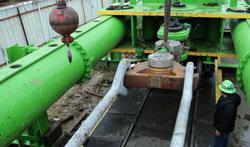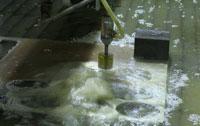Senior Editor
- FMA
- The Fabricator
- FABTECH
- Canadian Metalworking
Categories
- Additive Manufacturing
- Aluminum Welding
- Arc Welding
- Assembly and Joining
- Automation and Robotics
- Bending and Forming
- Consumables
- Cutting and Weld Prep
- Electric Vehicles
- En Español
- Finishing
- Hydroforming
- Laser Cutting
- Laser Welding
- Machining
- Manufacturing Software
- Materials Handling
- Metals/Materials
- Oxyfuel Cutting
- Plasma Cutting
- Power Tools
- Punching and Other Holemaking
- Roll Forming
- Safety
- Sawing
- Shearing
- Shop Management
- Testing and Measuring
- Tube and Pipe Fabrication
- Tube and Pipe Production
- Waterjet Cutting
Industry Directory
Webcasts
Podcasts
FAB 40
Advertise
Subscribe
Account Login
Search
No weak link allowed
Waterjet fabricates critical linkages for pull testing
- By Tim Heston
- September 2, 2011
- Article
- Waterjet Cutting

Figure 1: Holloway Houston Inc.’s testbed conducts a pull test. The testbed can exert up to 10 million pounds of pulling force.
The size of it all inspires when watching Holloway Houston’s insanely powerful testbed in action. Large lettering on the side, all capitalized, reads 5,000 TONS. If ever there were a measurement that called for a capitalized font, this would be it.
The testbed can exert up to 10 million pounds of pulling force, which essentially means it can destructively test nearly any movable structure on the planet, from wire or synthetic rope used in heavy-duty lifting to subsea structures for offshore oil platforms (see Figures 1 and 2). The testbed has yet to be pushed to the limit. The highest it has been pushed so far is 3,815 tons. Yes—tons.
If a product can be shipped to the company’s Houston facility, chances are Holloway Houston Inc. (HHI) can test it. The testbed is built and calibrated to ASTM E4, Standard Practices for Force Verification of Testing Machines. And it’s quite a sight. The testbed consists of three gigantic, parallel hydraulic cylinders powered by some jaw-dropping hydraulic motors. The system dwarfs the technicians standing nearby, and it’s a testament to how far destructive testing can go. After all, you can’t know with absolute certainty how strong a structure is unless you attempt to destroy it.
None of the testing could happen without carefully engineered linkages between the testbed and the part or structure being tested. If any link fails, those millions of pounds of pulling force prove nothing. Engineers must design the setup to ensure as much force as possible transfers away from the linkage and into the part or structure under stress.
This includes a custom hole-and-pin assembly that connects the components being pulled to the testbed’s pulling head. Huge components can look miniscule on such a massive contraption. For instance, the linkage assembly in this setup consists of a 6-in.-thick 4140 plate with a center hole cut to plus or minus a few thousandths. That tolerance is vital. If the heavy pin doesn’t mate perfectly, uneven forces will build up under stress that, even if it doesn’t cause the linkage to break, can affect the validity of the pull test results. This is where the company’s waterjet system comes into play.
Pull, Examine, Pull Again
Charles M. Chapman Sr. probably couldn’t have imagined today’s waterjet technology in 1960 when he opened HHI as a small distributor of wire rope and fittings. He and his son, Charles Moreland Chapman Jr. (or Moreland, as everyone calls him), grew the firm throughout the 1970s, eventually making it one of the largest distributors of fittings and wire rope in the world. In the 1990s the distributor expanded into make-to-order manufacturing, fabricating custom slings, containers, spreader bars, and lifting beams. At shipyards, docks, oil platforms, heavy industrial plants, and elsewhere, you may see lifting apparatus having components with lime green accents—HHI’s signature color, also used on its corporate logo.
Making lifting equipment obviously requires testing, and here Chapman thought big. Not only did he build testbeds for his own products, but for any product. Lifting applications put components under tremendous stress, which is why HHI tests the components before actual use.
Whatever the pull test application, the process starts the same way. Engineers meet with the customer to discuss specifics. If it makes sense to haul the product on-site, they will design a procedure and the custom fabrications required for use on HHI’s on-site testbed.
Most pull tests involve pulling a workpiece horizontally or vertically, but on occasion a workpiece requires diagonal force; in that case the HHI’s nine engineers design linkages and weldments that account for the unusual angle.
For lifting applications involving dockside or offshore lifting systems, HHI personnel may go to the customer’s site to conduct proof-load testing using water bags. The water is right there, so using the water as deadweight makes sense. If water isn’t available, steel will do. Here, HHI offers solid-weight testing services using everything from 5- to 1,000-ton lifting beams and baskets.
The company also offers nondestructive examination (NDE) services. After pull-testing a customer’s welded component, HHI engineers perform NDE on the welds using dye penetrant or ultrasonic testing. If the engineers detect cracks or other discontinuities serious enough to be categorized as defects (that is, the product failed the stress test), HHI’s fabricators will reweld the item and retest at the customer’s request. Having passed all requirements the item then is given a proof-test certificate of compliance.
Legacy Processes
Creating such a monstrous testbed wasn’t easy. Almost a decade ago, Chapman called on Bob Ruff and James Buffalo to build the power unit and control system for the new testbed. “We are still here working on new projects,” said Buffalo, who today works in the company’s special testing department.
“We maintain all of the company’s testbeds,” he said. “We also collaborate with our fabrication division, which has undergone some significant equipment upgrades in recent years.”
Several years ago, when engineers sent drawings for linkage components needed for a particular test, the shop outsourced some of the precision cutting work. The company does have in-house drilling and machining, but such metal cutting equipment usually was too busy making other parts for HHI’s custom fabrication business. To cut many of the workpieces out of thicker material—upwards of 6 in. —the company had no choice but to outsource, because its machinery just couldn’t handle it.
Up until last year the company had limited plate-cutting capability. Workers sometimes would perform rough cuts with hand torches, and if anything more precise was needed, paper drawings would be sent to an oxyfuel cutting system with a photo-eye sensor. The sensor read the paper drawing like a template, guiding the oxyfuel torch along the path. It was slow and, using oxyacetylene gas, not terribly accurate.
Waterjet Complementing Oxyfuel
That oxyfuel machine still cuts parts for many applications, but complementing it now is a new waterjet system from Koike Aronson, using a 60,000-PSI KMT pump (see Figure 3), along with a Koike four-head thermal cutting table. The four-head oxyfuel machine has high torch-positioning accuracy, with drive motors on either side of the gantry. The two motors work together to position the oxyfuel torches so that they can cu to tight tolerances. The system cuts with a propane mixture, which, according to sources, can yield cleaner cuts compared with traditional oxyacetylene.
It’s still not as accurate as the waterjet, of course. HHI’s waterjet system can cut on five different settings ranging from very fine to rough cut. For each setting the machine adjusts the feed rate and other waterjet parameters.
Soon after the waterjet system was installed, the technology proved its usefulness. The fab shop needed to repair a 1,000-lb. ram used on a 4,000-ton swaging press. The ram’s massive end cap needed to be cut out. Previously HHI would have been forced to purchase a new ram. But with the waterjet installed, workers placed the ram on the cutting table and fixtured it in place on its side. The waterjet nozzle, which can move upward in Z, proceeded to cut the end cap off to the required tolerance. Then a new end cap was welded on, and the repair was complete.
HHI’s oxyfuel and waterjet systems complement each other. The exported DXF file can show multiple layers, some for the geometries handled by the waterjet, and others handled by the oxyfuel system. Today the engineering department makes the drawings and sends the plate to the waterjet for the critical dimensions, such as the inside diameter of a precision hole. Then, to avoid tying up the waterjet system, they send the part to the oxyfuel system for the noncritical dimensions.
The four oxyfuel heads have seriously upgraded the shop’s cutting capacity. The company fabricates deadweights used for testing offshore cranes, dockside lifting devices, and other equipment. HHI can cut large sections out of very thick plate. At this writing, the company has 1.2 million pounds of deadweights for rent. Manufacturing these takes a serious amount of cutting, and the four-head oxyfuel system greatly reduced the time to churn through all that metal. The four-head oxyfuel machine is cutting steel to bring the total deadweight available in-house to 1,000 tons. Yes, tons.

Figure 3: HHI uses its waterjet system to cut, among other things, the critical components that go into a pull-test setup. Photo courtesy of Koike Aronson Inc.
Earlier this year HHI installed Ethernet cable between the engineering department and the front offices of the fabrication shop. The arrangement has information flowing fast, and also represents another step away from relying solely on paper drawings. Engineers order the metal they need, then send the digital file directly over to fabrication. The DXF then is exported to the oxyfuel and waterjet cutting machines on the floor.
Pulling Hard for Fast Growth
Such fabrication supports a fast-growing business. Today HHI still distributes chains, shackles, and cables for heavy lifting. Its custom fabrication and testing divisions have helped the company grow rapidly during the past decade. Even the recession didn’t slow growth significantly. Business slowed for a few months in 2009 but picked back up later in the year.
Chapman’s business strategy apparently is paying off, with growth continuing through some economically tumultuous years. Six years ago the company had 93 employees. Today HHI employs more than 250.
About the Author

Tim Heston
2135 Point Blvd
Elgin, IL 60123
815-381-1314
Tim Heston, The Fabricator's senior editor, has covered the metal fabrication industry since 1998, starting his career at the American Welding Society's Welding Journal. Since then he has covered the full range of metal fabrication processes, from stamping, bending, and cutting to grinding and polishing. He joined The Fabricator's staff in October 2007.
Related Companies
subscribe now

The Fabricator is North America's leading magazine for the metal forming and fabricating industry. The magazine delivers the news, technical articles, and case histories that enable fabricators to do their jobs more efficiently. The Fabricator has served the industry since 1970.
start your free subscription- Stay connected from anywhere

Easily access valuable industry resources now with full access to the digital edition of The Fabricator.

Easily access valuable industry resources now with full access to the digital edition of The Welder.

Easily access valuable industry resources now with full access to the digital edition of The Tube and Pipe Journal.
- Podcasting
- Podcast:
- The Fabricator Podcast
- Published:
- 04/16/2024
- Running Time:
- 63:29
In this episode of The Fabricator Podcast, Caleb Chamberlain, co-founder and CEO of OSH Cut, discusses his company’s...
- Industry Events
16th Annual Safety Conference
- April 30 - May 1, 2024
- Elgin,
Pipe and Tube Conference
- May 21 - 22, 2024
- Omaha, NE
World-Class Roll Forming Workshop
- June 5 - 6, 2024
- Louisville, KY
Advanced Laser Application Workshop
- June 25 - 27, 2024
- Novi, MI
































